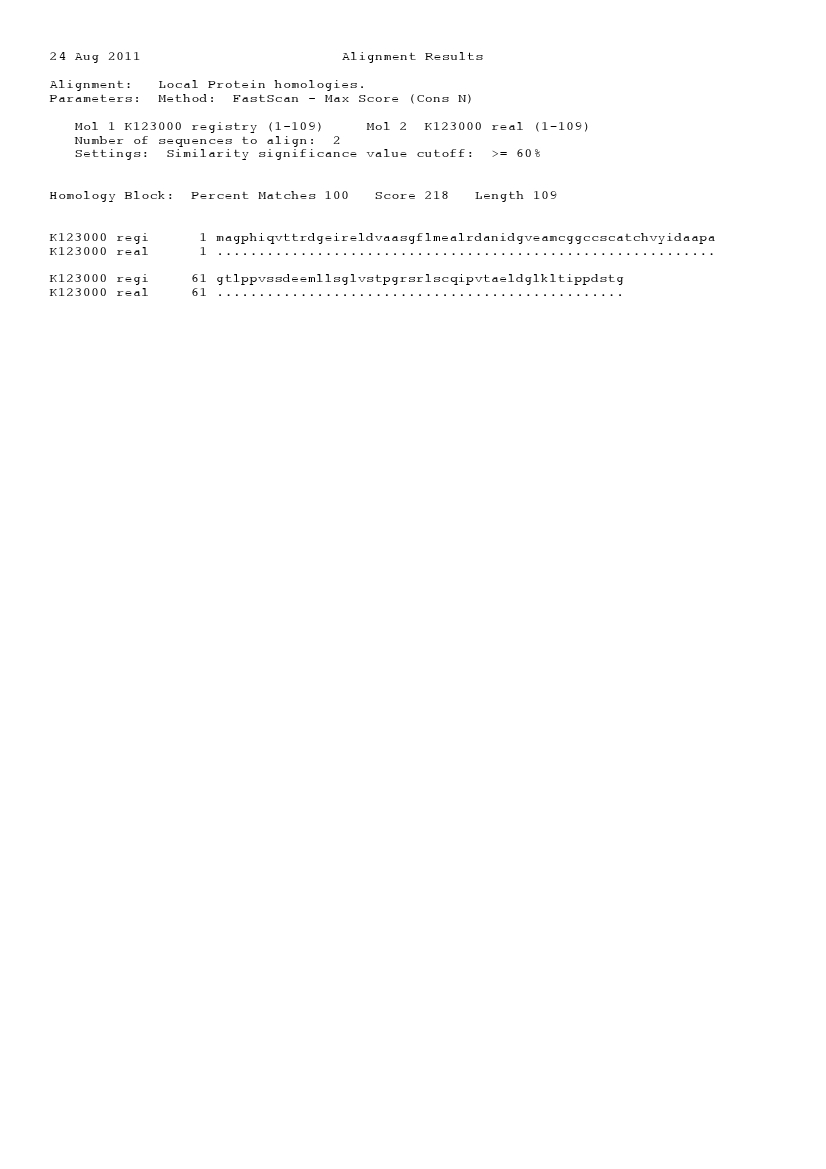Part:BBa_K123000:Experience
This experience page is provided so that any user may enter their experience using this part.
Please enter
how you used this part and how it worked out.
Applications of BBa_K123000
User Reviews
UNIQb00812bfe5f3d056-partinfo-00000000-QINU UNIQb00812bfe5f3d056-partinfo-00000001-QINU
|
••••
Bielefeld-Germany 2011 |
Wrong sequence in the parts.igem! Sequence is not entered into the parts.igem correctly. This BioBrick was probably synthesized in the Freiburg assembly standard 25 because it has the accordant restriction sites and it was codon optimized for Escherichia coli but the original sequence from Sphingomonas bisphenolicum was entered to the registry because amino acid sequence of the real sequence and the sequence that was entered is identical (translated in silico).
 Fig. 1: Alignment of the DNA sequence of BBa_K123000 entered into the parts.igem (K123000 registry) with our sequencing results (K123000 real) for this BioBrick (made with Clonemanager).  Fig. 2: Alignment of the aminoacid sequence (translated in silico) of BBa_K123000 entered into the parts.igem (K123000 registry) with our sequencing results (K123000 real) for this BioBrick (made with Clonemanager).
Bisphenol A degradation with BioBricks BBa_K123000 and BBa_K123001 The bisphenol A degradation with the BioBricks BBa_K123000 and BBa_K123001 works in E. coli KRX in general. Because [http://onlinelibrary.wiley.com/doi/10.1111/j.1365-2672.2008.03843.x/full Sasaki et al. (2008)] reported problems with protein folding in E. coli which seem to avoid a complete BPA degradation, we did not use the strong T7 promoter for expressing these BioBricks but a medium strong constitutive promoter (BBa_J23110). With this promoter upstream of a polycistronic bisdAB gene we were able to completely degrade 120 mg L-1 BPA in about 30 - 33 h. By fusing BBa_K123000 and BBa_K123001 together we could improve the BPA degradation of E. coli even further, so 120 mg L-1 BPA can be degraded in 21 - 24 h. This data is shown in the following figure: Error creating thumbnail: Invalid thumbnail parameters Figure 3: BPA degradation by E. coli KRX carrying genes for BisdA and BisdB (only bisdA (black), polycistronic bisdAB (red) and fusion protein between BisdA and BisdB (green)) behind the medium strong constitutive promoter BBa_J23110 with RBS BBa_B0034. Cultivations were carried out at 30 °C in LB + Amp + BPA medium for 24 h and 36 h, respectively, with automatic sampling every three hours in 300 mL shaking flasks without baffles with silicon plugs. At least three biological replicates were analysed (three for bisdA alone, seven for bisdAB polycistronic and five for the fusion protein). We also carried out these cultivations at different temperatures and BPA concentrations, but the chosen conditions (30 °C and 120 mg L-1 BPA) seem to be the best. Higher BPA concentrations have an effect on the growth of E. coli and higher temperature leeds to a worse BPA degradation (probably due to misfolding of the enzymes). These data on the effect of the temperature on the BPA degradation is shown in fig. 4. Error creating thumbnail: Invalid thumbnail parameters Figure 4: BPA degradation by E. coli KRX carrying genes for BisdA and BisdB (polycistronic bisdAB (black) and fusion protein between BisdA and BisdB (striped)) behind the medium strong constitutive promoter BBa_J23110 with RBS BBa_B0034. Cultivations were carried out at different temperatures in LB + Amp + BPA medium (starting concentration 120 mg L-1 BPA) for 24 h in 300 mL shaking flasks without baffles with silicon plugs. Samples were taken at the end of the cultivation. Three biological replicates were analysed. As shown by [http://onlinelibrary.wiley.com/doi/10.1111/j.1365-2672.2008.03843.x/full Sasaki et al. (2008)], BisdB expressed in E. coli leeds to hardly no BPA degradation. In our experiments we could not detect the BPA degradation products 1,2-Bis(4-hydroxyphenyl)-2-propanol and 2,2-Bis(4-hydroxyphenyl)-1-propanol in cultivations with E. coli expressing BBa_K123000 or BBa_K123001 alone (neither via UV- nor MS-detection). The BPA degradation products 1,2-Bis(4-hydroxyphenyl)-2-propanol and 2,2-Bis(4-hydroxyphenyl)-1-propanol were identified via MS-MS (m/z: 243 / 225 / 211 / 135) and only occured in cultivations with E. coli expressing BisdA and BisdB together. So in the fusion protein, both domains (BisdA and BisdB) are active and correctly folded because otherwise there would be no BPA degradation product. The higher specific BPA degradation rate in E. coli expressing BisdA | BisdB fusion protein could be explained either by improved folding properties of the fusion protein or by the closer distance of BisdA and BisdB in the fusion protein leeding to a more efficient reaction.
Methods
Cultivations 
HPLC method
|

 1 Registry Star
1 Registry Star